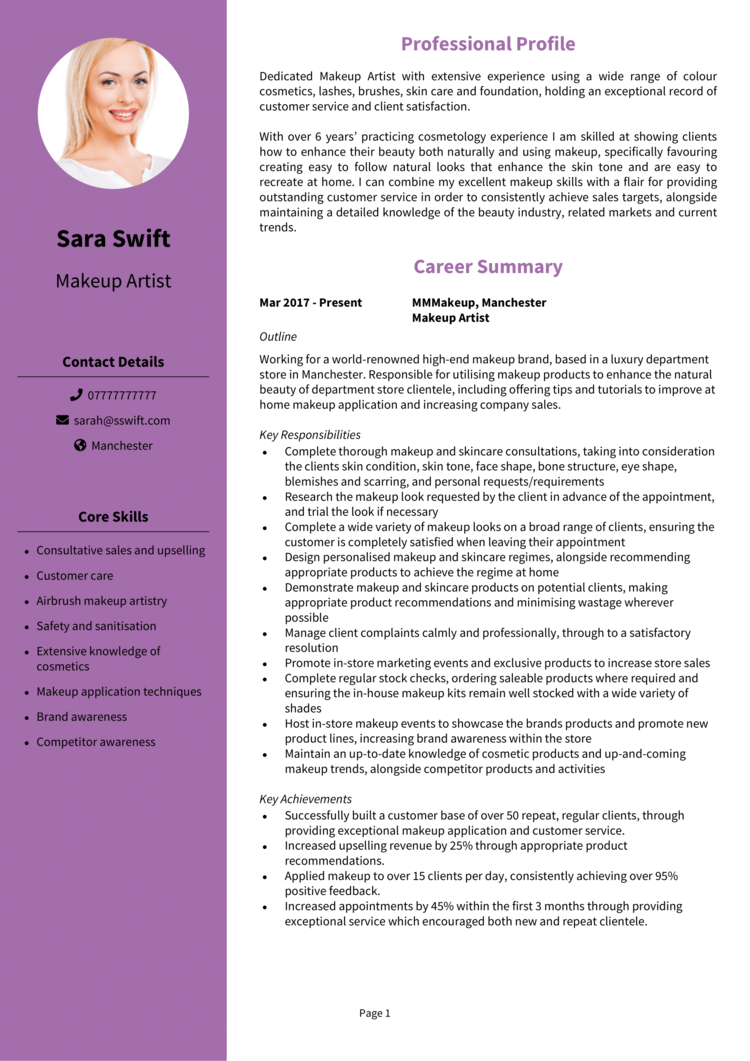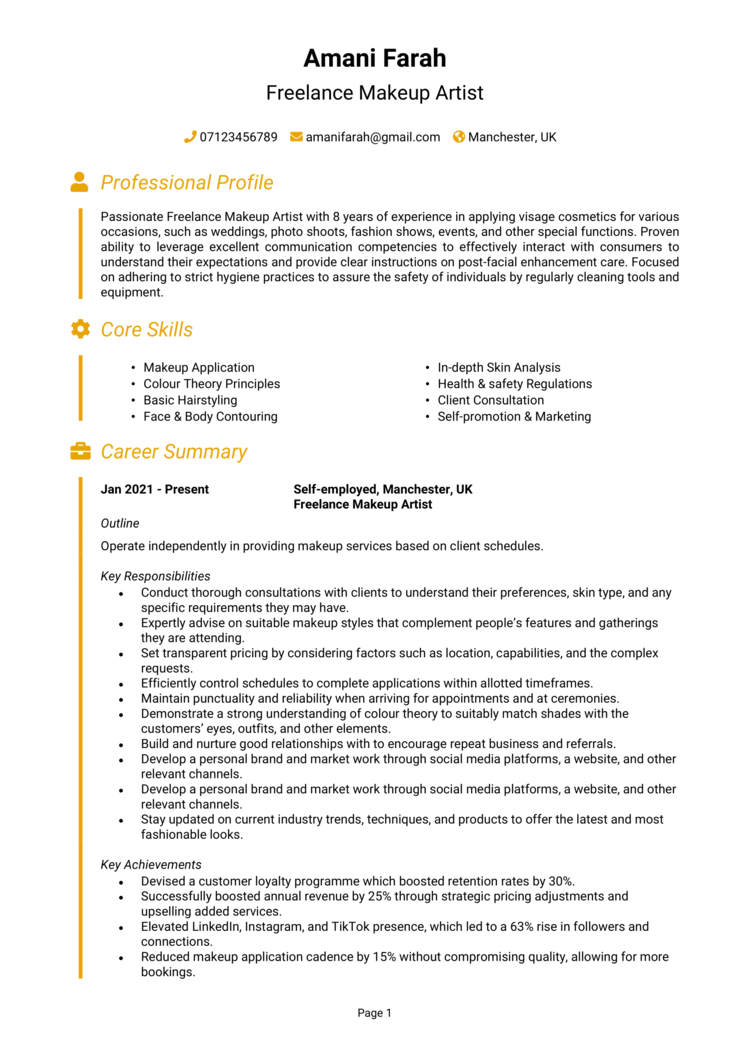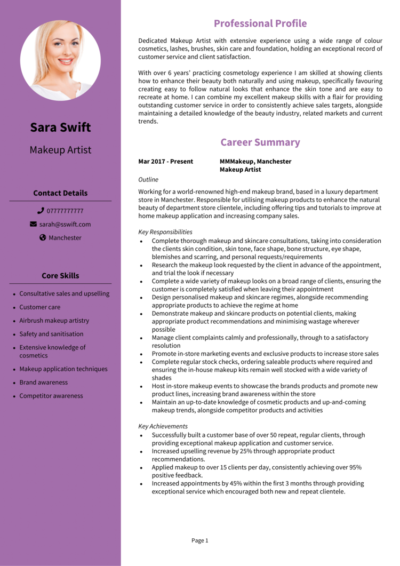Ready to create bold looks and flawless finishes for your dream clients? As a makeup artist, your talent transforms faces, but your CV needs to make an impression too.
Your artistry can make people look and feel like their best selves, but when it comes to your CV, there’s no filter to hide the flaws – so let’s make it flawless. Following this guide, complete with some perfected Makeup Artist CV examples, will have a good CV to help you land interviews for exciting new roles, and let your artistry shine in the beauty industry.
Makeup Artist CV

Freelance Makeup Artist CV

How to write your Makeup Artist CV
Learn how to create your own interview-winning Makeup Artist CV with this simple step-by-step guide.
A Makeup Artist CV isn’t just about listing jobs; it’s your chance to showcase your skills, aesthetic, and professionalism. These steps will show you that writing a CV must emphasise your experience, technical expertise, and ability to deliver stunning results, helping you step into the most glamorous roles.
Makeup Artist CV structure


Think of your CV structure as your beauty kit – it needs to be well-organised, versatile, and packed with the essentials to wow every recruiter who takes a look. Keeping a tidy layout will make sure recruiters are engaged the entire way.
Your Makeup Artist CV should be structured as follows:
- Name and contact details – Display contact details at the top for easy access. Including a picture of yourself is entirely optional but could work for a creative portfolio.
- Profile – Open with a summary of your beauty industry experience, technical skills, and career highlights.
- Core skills – Next, state the key aspects of your expertise, from bridal makeup to prosthetics and airbrushing.
- Work experience – Showcase your roles in reverse chronological order, emphasising the impact you’ve made clearly in your CV.
- Education – Go through any beauty certifications, makeup courses, academic qualifications, or awards.
- Additional info – Include anything from your hobbies and interests to the languages you speak – these are all totally optional.
Makeup Artist CV format


Your CV format and design should be as flawless as a perfectly blended contour. A clean, professional layout ensures your skills stand out for all the right reasons – not for any mistakes.
Here’s how to format your Makeup Artist CV effectively:
- Bullet points – Use these to highlight key skills and achievements quickly and clearly.
- Divide sections – Separate your CV into distinct areas for easy navigation.
- Use a clean font – Stick to professional and clean fonts, and a sensible colour scheme.
- Keep it the right length – Keep it concise to maintain their interest while still covering all the essentials. The length should be no longer than 2 pages.
What is a Makeup Artist CV profile?


Your profile is your chance to catch the recruiter’s eye and prove why you’re the perfect choice for the role. With just a short paragraph, you’ll need to convey to any reader what benefits and value you’d bring to the table, and why they should hire you, like a very shortened cover letter.
Makeup Artist CV profile examples
Profile 1
Creative Makeup Artist with five years of experience specialising in bridal, fashion, and editorial makeup. Skilled in enhancing natural beauty, creating custom looks, and collaborating with photographers and stylists. Known for delivering flawless results under tight deadlines.
Profile 2
Dedicated Makeup Artist with three years of experience in TV and film production, adept at creating character-driven looks and ensuring continuity across scenes. Proficient in using industry-standard products and techniques to meet creative briefs.
Profile 3
Experienced Makeup Artist with over eight years of expertise in retail and brand consultancy, specialising in skincare and beauty product demonstrations. Skilled in building client relationships, driving sales, and training teams on makeup application techniques.
What to include in your Makeup Artist CV profile
Follow these tips on what to include in your Makeup Artist CV profile:
- Where you’ve worked – Say which sort of salons, fashion shows, or TV productions you’ve contributed to.
- Your top qualifications – Also h certifications like NVQ Beauty Therapy or specific makeup artistry training.
- Specialised skills – Quickly mention your expertise in areas like airbrushing, SFX, or editorial makeup.
- Client types – Include whether you’ve worked with brides, actors, or models.
- Portfolio highlights – Make sure to note standout projects or collaborations which might be impressive to a recruiter.
Show off the core skills recruiters look for


Your core skills section is your CV’s highlight reel – showcasing the abilities that make you a standout makeup artist. Tailor this section to reflect the role, whether it’s bridal beauty, editorial work, or high-fashion styling.
What to include in a Makeup Artist CV skills section
- Skin Preparation Techniques – Prepping skin with appropriate products to ensure a smooth and long-lasting application.
- Foundation Matching – Selecting and blending foundation shades to match diverse skin tones seamlessly.
- Contouring and Highlighting – Enhancing facial features using advanced contouring and highlighting techniques.
- Special Effects Makeup – Creating realistic effects for film, theatre, or themed events using prosthetics and specialised products.
- Airbrush Makeup Application – Using airbrush tools for a flawless and lightweight finish suitable for HD photography and video.
- Brow Shaping and Defining – Sculpting and defining eyebrows to complement facial structure and overall makeup.
- Bridal and Event Makeup – Designing long-lasting looks tailored to weddings, proms, and other special occasions.
- Product Knowledge – Understanding makeup brands and products to select the best tools and formulas for each client.
- Hygiene and Sanitation – Following strict hygiene practices to maintain a safe and clean working environment.
- Colour Theory Application – Combining colours effectively to create harmonious and visually appealing looks.
Work experience


Your work experience section is where you demonstrate your impact in previous roles. Recruiters will always prefer somebody who can show that they’ve put their skills to use in a real-world, practical setting.
Highlight the variety and creativity of your work, as well as your professionalism. If you’re low on professional experience, mention any experience that tells a story about your creativity and willingness to learn, like doing makeup at a friend’s wedding. Always list roles in reverse chronological order.
Structuring your jobs

- Outline – Provide a brief description of the project, employer, or event, and your role in it.
- Responsibilities – Highlight tasks like creating custom looks, collaborating with photographers, or managing client consultations.
- Achievements – Include measurable outcomes, like client satisfaction, notable events, or repeat bookings. Use numbers whenever possible to really convey the tangible impact you’ve made.
Example jobs for Makeup Artist
Makeup Artist | Elegant Expressions
Outline
Provided bridal and special event makeup services for a boutique studio, focusing on creating customised looks for clients on their special day. Delivered exceptional service to ensure client satisfaction.
Responsibilities
- Consulted with clients to understand their preferences and create personalised makeup looks.
- Applied long-lasting, high-definition makeup suitable for photography and video.
- Managed tight schedules to provide services for bridal parties of up to 10 individuals.
- Recommended skincare and beauty products to prepare clients ahead of events.
- Maintained a clean and hygienic workspace, adhering to industry standards.
Achievements
- Increased repeat bookings by 30 percent through exceptional client experiences.
- Praised by brides for creating timeless, photo-ready looks that exceeded expectations.
- Recognised by studio management for professionalism and ability to handle high-pressure situations.
Makeup Specialist | StudioVision Productions
Outline
Worked as a makeup artist for a TV and film production company, creating character-driven looks for actors in various genres. Focused on meeting creative briefs and maintaining continuity.
Responsibilities
- Designed and applied makeup for actors, aligning with character profiles and storylines.
- Collaborated with directors and costume designers to ensure cohesive on-screen appearances.
- Maintained continuity by documenting looks for each scene and episode.
- Used special effects makeup to create injuries, aging effects, and other transformations.
- Managed inventory of makeup products, ensuring availability during production.
Achievements
- Reduced production delays by maintaining quick touch-up services during shoots.
- Delivered award-nominated character looks for an independent film project.
- Commended by directors for precision and adaptability on demanding sets.
Makeup Artist | Glowing Boutique
Outline
Worked as a retail makeup artist for a luxury cosmetics brand, providing personalised consultations and driving sales through product demonstrations. Focused on delivering excellent customer service and brand representation.
Responsibilities
- Performed makeup applications for customers, tailoring techniques to suit individual features.
- Educated clients on proper product usage and skincare routines to enhance results.
- Organised in-store events, including makeup workshops and product launches.
- Trained junior staff on makeup application techniques and customer interaction skills.
- Monitored inventory levels to ensure availability of popular products.
Achievements
- Increased monthly sales by 20 percent through personalised consultations and product recommendations.
- Developed and delivered training sessions that improved team performance by 15 percent.
- Recognised by management as a top-performing artist for consistently exceeding sales targets.
How to write your education section


Whether you’ve trained with top professionals or mastered your craft through countless YouTube tutorials, the education section is where you show off your skills foundation (and foundation skills).
Talk about your qualifications like diplomas in beauty therapy, SFX makeup training, or online courses. For self-taught artists, list workshops or certifications to showcase your commitment to learning.
Always list qualifications in reverse chronological order, starting with the most recent.
Best qualifications for Makeup Artists
- Level 3 NVQ Diploma in Beauty Therapy (Makeup) – Covers makeup application, skincare, and beauty treatments.
- SFX Makeup Artist Certification – Demonstrates expertise in special effects makeup for film and TV.
- Airbrush Makeup Training – Highlights advanced skills in airbrush techniques for a flawless finish.
- Professional Makeup Artist Diploma – Validates comprehensive training in all aspects of makeup artistry.





